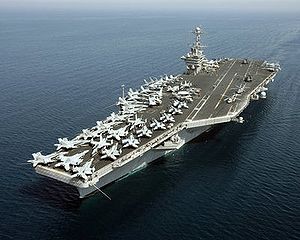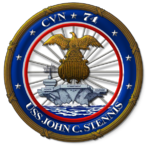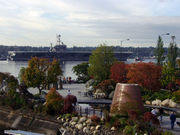USS John C. Stennis (CVN-74)
 USS John C. Stennis in May 2007 |
|
| Career (United States) | |
|---|---|
| Name: | USS John C. Stennis |
| Namesake: | John C. Stennis |
| Builder: | Newport News Shipbuilding Co. |
| Laid down: | 13 March 1991 |
| Launched: | 11 November 1993 |
| Christened: | 11 November 1993 |
| Commissioned: | 9 December 1995 |
| Homeport: | NB Kitsap, Washington |
| Motto: | Look Ahead |
| Nickname: | Johnny Reb |
| Status: | in active service, as of 2011[update] |
| Badge: |  |
| General characteristics | |
| Class and type: | Nimitz-class aircraft carrier |
| Displacement: | 103,300 long tons (115,700 short tons)[1] |
| Length: | Overall: 1,092 feet (332.8 m) Waterline: 1,040 feet (317.0 m) |
| Beam: | Overall: 252 ft (76.8 m) Waterline: 134 ft (40.8 m) |
| Draught: | Maximum navigational: 37 ft (11.3 m) Limit: 41 ft (12.5 m) |
| Propulsion: | 2 × Westinghouse A4W nuclear reactors 4 × steam turbines 4 × shafts 260,000 shp (194 MW) |
| Speed: | 30+ knots (56+ km/h; 35+ mph) |
| Range: | Essentially unlimited distance; 20 years |
| Capacity: | 6500 officers and crew (with embarked airwing) |
| Complement: | Ship's company: 3,200 Air wing: 2,480 |
| Sensors and processing systems: |
AN/SPS-48E 3-D air search radar AN/SPS-49(V)5 2-D air search radar AN/SPQ-9B target acquisition radar AN/SPN-46 air traffic control radars AN/SPN-43C air traffic control radar AN/SPN-41 landing aid radars 4 × Mk 91 NSSM guidance systems 4 × Mk 95 radars |
| Electronic warfare and decoys: |
SLQ-32A(V)4 Countermeasures suite SLQ-25A Nixie torpedo countermeasures |
| Armament: | 2 × Mk 57 Mod3 Sea Sparrow 2 × RIM-116 Rolling Airframe Missile 3 × Phalanx CIWS |
| Armour: | Classified |
| Aircraft carried: | 90 fixed wing and helicopters |
USS John C. Stennis (CVN-74) is the seventh Nimitz-class nuclear-powered supercarrier in the United States Navy, named for Senator John C. Stennis of Mississippi. She was commissioned on 9 December 1995. Her home port is Bremerton, Washington.
Contents |
Mission and capabilities
The mission of Stennis and her embarked Air Wing (CVW-9) is to conduct sustained combat air operations while forward deployed in the global arena. The embarked Air Wing consists of eight to nine squadrons. Attached aircraft are Navy and Marine F/A-18 Hornet, EA-6B Prowler, MH-60R, MH-60S, and E-2C Hawkeye.
The Air Wing can engage enemy aircraft, submarines, and land targets, or lay mines hundreds of miles from the ship. Stennis's aircraft are used to conduct strikes, support land battles, protect the Battle Group or other friendly shipping, and implement a sea or air blockade. The Air Wing provides a visible presence to demonstrate American power and resolve in a crisis. The ship normally operates as the centerpiece of a Carrier Battle Group commanded by a flag officer embarked upon Stennis and consisting of four to six other ships.
Stennis's two nuclear reactors give her virtually unlimited range and endurance and a top speed in excess of 30 knots (56 km/h, 34.5 mph). The ship's four catapults and four arresting gear engines enable her to launch and recover aircraft rapidly and simultaneously. The ship carries approximately three million gallons (11,000 m³) of fuel for her aircraft and escorts, and enough weapons and stores for extended operations without replenishment. Stennis also has extensive repair capabilities, including a fully equipped Aircraft Intermediate Maintenance Department, a micro-miniature electronics repair shop, and numerous ship repair shops.
For defense, in addition to her Air Wing and accompanying vessels, Stennis has NATO RIM-7 Sea Sparrow and Rolling Air Missile (RAM) surface-to-air missile systems, the Phalanx Close-in Weapons System for cruise missile defense, and the SLQ-32 Electronic Warfare System.
Miscellaneous
- Sponsor: Mrs. Margaret Stennis Womble
- Nickname: 'Johnny Reb'
- Contract Date: 29 March 1988
- Crew size: 5,617 (including air wing)
- Meals served daily: 16,600
- Number of compartments: 2,700
- Number of anchors: 2 (From USS Forrestal)
- Weight of anchors: 30 long tons (30 metric tons) each
- Number of screws: 4 (5 blades each)
- Weight of screws: 66,200 lb (30 t) each
- Number of catapults: 4
- Number of aircraft elevators: 4
- A/C plant capacity: 2,900 refrigeration tons (10.2 megawatts, enough to service 950 homes)
- Distillation plant capacity: 400,000 U.S. gallons (1,500 m³) (enough to serve 2,000 homes)
- Number of telephones: 2,000
- Tons of structural steel: More than 60,000 short tons (55,000 metric tons)
- Length of cable and wiring: over 900 miles (1,500 km)
- Number of light fixtures: more than 30,000
- Required technical manuals: A stack as high as the Washington Monument at 555 feet (170 m)
- Bed mattresses: If lined up end-to-end, they would stretch more than 9 miles (14 km)
- Sheets: 28,000
- Pillow Cases: 14,000
- Cost: $4.5 billion; projected service life: 50 years
- Appears in Disneyland's California Adventure attraction "Soarin' Over California" and Walt Disney World Epcot's attraction "Soarin'
The crew of the ship were interviewed as part of an episode of the NPR\WBEZ show This American Life which first aired on 01.03.2002 and was re-broadcast 18.03.2005. Show producers Wendy Dorr, Alex Blumberg and Ira Glass visited the Stennis in January of 2002, about six weeks into its deployment. The show notes describe it as follows:
Life aboard the USS John C. Stennis, an aircraft carrier in the Arabian Sea that's supporting bombing missions over Afghanistan as part of Operation Enduring Freedom. Only a few dozen people on board actually fly F-18s and F-14s. It takes the rest of the crew — over 5,000 people — to keep them in the air. One person stocks vending machines, twelve hours a day. Hundreds prepare food and do laundry. There are several different garage bands, each with its own following.
It is possible to listen to the show from the This American Life archive (http://www.thisamericanlife.org/Radio_Episode.aspx?episode=206).
History
The nuclear-powered USS John C. Stennis (CVN 74) was contracted on 29 March 1988, and the keel was laid on 13 March 1991 at Newport News Shipbuilding Co., Newport News, Va.
The ship was christened on 11 November 1993, in honor of Senator John Cornelius Stennis (D-Mississippi) of who served in the Senate from 1947 to 1989. The daughter of the ship’s namesake, Mrs. Margaret Stennis-Womble was the ship’s sponsor. Stennis was commissioned on 9 December 1995 at Naval Station Norfolk, Va, and she conducted flight deck certification in January 1996. The first arrested landing was by a VX-23 F-14B. The ship conducted numerous Carrier Qualifications and Independent Steaming Exercises off the East Coast throughout the next two years. Included among these events was the first carrier landing of an F/A-18E/F Super Hornet on 18 January 1997.
1998 - World Cruise
_&_HMS_Illustrious_(R_06).jpg)
On 26 February 1998 with Carrier Air Wing Seven embarked, Stennis left Norfolk for her maiden deployment, transiting the Suez Canal on 7 March and arriving in the Persian Gulf on 11 March 1998. The ship travelled 8020 nm in 274 hours, an average speed of 29.4 knots (54.4 km/h) to relieve USS George Washington (CVN-73) in conducting Operation Southern Watch missions. Stennis departed the Persian Gulf on 19 July 1998 for her new home port of Naval Air Station North Island in San Diego, California, arriving on 26 August 1998.
In October 1998, Stennis entered a 6-month Phased Incremental Availability for maintenance and upgrades at North Island, returning to sea in April 1999. During the maintenance period, a jet blast deflector collapsed, severely injuring two sailors.
On 30 November 1999, Stennis ran aground in a shallow area adjacent to the turning basin near North Island. Silt clogged the intake pipes to the steam condensing systems for the nuclear reactor plants, causing the carrier’s two nuclear reactors to be shut down (one reactor by crew, the other automatically) for a period of 45 minutes. Stennis was towed back to her pier for maintenance and observation for the next two days. The cleanup cost was about $2 million.
2000 - Persian Gulf/Pacific Ocean
On 7 January 2000, Stennis deployed to the Persian Gulf to relieve USS John F. Kennedy (CV-67) in Operation Southern Watch. During the deployment, the ship made port visits to South Korea, Hong Kong, Malaysia, Bahrain, the United Arab Emirates and Australia, before returning to San Diego on 3 July 2000.
Following the 11 September 2001 terrorist attacks, Stennis conducted Noble Eagle missions off the U.S. West Coast.
2001 - Persian Gulf
On 12 November 2001, two months earlier than scheduled, the ship left on her third deployment to the U.S. Fifth Fleet area of responsibility in support of Operation Enduring Freedom, returning to San Diego on 28 May 2002. From June 2002 to January 2003, JCS underwent a seven-month Planned Incremental Availability (PIA).
2004 - Pacific Ocean
From 24 May to 1 November 2004, Stennis conducted her fourth major overseas deployment, participating in Exercise Northern Edge 2004 in the Gulf of Alaska, Rim of the Pacific (RimPac) Exercise off Hawaii, exercises with Kitty Hawk off Japan and goodwill visits to Japan, Malaysia and Western Australia. Shortly after returning from deployment to San Diego, JCS changed her home port to Naval Station Bremerton, Washington on19 January 2005. Once at Bremerton, Stennis underwent an 11 month Docking Planned Incremental Availability (DPIA), the first time she had been dry-docked since commissioning. Upgrades included a new mast.
2007 - Persian Gulf

On 20 January 2007, Stennis set sail for the Persian Gulf as part of an increase in US military presence within the Middle East. Stennis arrived in the area on 19 February 2007, joining USS Dwight D. Eisenhower in the United States Fifth Fleet area of operations.[2] This marked the first time since 2003 that there were two aircraft carrier battle groups in the region simultaneously.
On 23 May 2007 Stennis, along with eight other warships including the aircraft carrier Nimitz and amphibious assault ship Bonhomme Richard, passed through the Strait of Hormuz. US Navy officials said it was the largest such move since 2003.[3]
On 31 August 2007 Stennis returned to Bremerton.
2009 - Western Pacific
Stennis departed Bremerton for a 6-month deployment to the Western Pacific on 13 January 2009. On 24 April, the ship arrived in Singapore. That same day, one of the ship's sailors was crushed and killed while working from a small harbor boat to secure a drain that discharges oily water from Stennis’ aircraft catapults.[4]
On 29 April, the ship's executive officer, Commander David L. Burnham, was relieved by Rear Admiral Mark A. Vance over unspecified personal conduct. Burnham was reassigned to a base in San Diego, pending an investigation.[5]
After participating in operations in the Persian Gulf, exercises with Japan Maritime Self Defense Force and the Republic of Korea, as well as joint exercise Northern Edge 2009, USS Stennis returned from deployment in early July 2009. Carrier Air Wing 9 debarked on 6 July at NAS North Island,[6] prior to the ship's arrival at her homeport of Bremerton, Wash., on 10 July.[7]
John C. Stennis Carrier Battle Group

The JCS battlegroup (or Carrier Strike Group 3, CSG-3) is equipped and trained to work as a forward deployed force providing a deterrent force as well as serving to protect U.S. interests abroad.
The Stennis is the flagship of the battlegroup, and commands the group's air wing Carrier Air Wing 9. The Stennis is also home to the commander of Destroyer Squadron 21 (DESRON 21).
Ships of DESRON 21
- USS Halsey (DDG-97)
- USS Howard (DDG-83)
- USS Jarrett (FFG-33)
- USS Preble (DDG-88)
- USS Rentz (FFG-46)
Other elements of JCS Battle Group
- USS Mobile Bay (CG-53)
- USS O'Kane (DDG-77)
- USNS Bridge (T-AOE-10)
Squadrons of CVW-9

- Strike Fighter Squadron 192 (VFA-192) "Golden Dragons"
- Strike Fighter Squadron 154 (VFA-154) "Black Knights"
- Marine Fighter Attack Squadron (VMFA-323) "Death Rattlers"
- Strike Fighter Squadron 146 (VFA-146)"Blue Diamonds"
- Strike Fighter Squadron 147 (VFA-147) "Argonauts"
- Electronic Attack Squadron 138 (VAQ-138) "Yellow Jackets"
- Carrier Airborne Early Warning Squadron 112 (VAW-112)"Golden Hawks"
- Helicopter Sea Combat Squadron 8 (HSC-8) "Eight-Ballers"
- Helicopter Maritime Strike Squadron 71 HSM-71 "Raptors"
- Fleet Logistics Support Squadron 30 Detachment 4 (VRC-30)"Providers"
Ship's seal

John C. Stennis's Seal was produced from the combined efforts of several crew members with historical help from Stennis Center for Public Service, John C. Stennis Space Center and United States Senate Historian. The Seal implies peace through strength, just as Senator John C. Stennis was referred to as an "unwavering advocate of peace through strength" by President Ronald Reagan, when the ship's name was announced in June 1988.
The circular shape signifies the Nimitz-class aircraft carrier's unique capability to circle the world without refueling while providing a forward presence from the sea. The predominant colors are red, white, blue and gold, the same as those of the United States and its navy. The outer border, taken from one version of a U.S. Senate crest, represents the strength through unity of the ship's crew. The four gold bands and eight ties denote John C. Stennis' four decades (41 years) in the Senate and the eight presidents he served with, from President Truman to President Reagan. The seven stars in the blue border represent his seven terms in the Senate and characterize John C. Stennis as the seventh Nimitz-class aircraft carrier. The red and white stripes inside the blue border represent the American flag and the American people John C. Stennis serves. They also honor the courage and sacrifice of the United States' armed forces.
The eagle and shield is a representation of the gilt eagle and shield overlooking the Old Senate Chamber. The shield represents the United States of America. The twenty stars represent the US's twentieth state, Mississippi, the home of John C. Stennis. The three arrows in the eagle's talons symbolize the Ship and Air Wing's ability to project power. The burst of light emanating from the shield, representative of the emergence of a new nation in the United States Senate Seal, portrays the birth of over 25 major Naval Aviation programs under Senator Stennis' leadership, including all aircraft carriers from Forrestal to Harry S. Truman, and aircraft from the F-4 Phantom to the F/A-18 Hornet. The eagle is representative of John C. Stennis' stature in the Senate, where he was respected and admired as a "soaring eagle" by some of his colleagues.
The ship itself is pictured in the seal. On the edges of the flight deck are the words "Honor, Courage, Commitment" which are the United States Navy's Core Values.
The Seal, after selection by the ship's crew, was submitted to Mrs. Margaret Stennis Womble, the ship's Sponsor and daughter of Senator Stennis, and to Mrs. John Hampton Stennis, the Matron of Honor and wife of Senator Stennis' son, for their approval. In February 1995 they approved the design.
See also
- List of aircraft carriers
- List of aircraft carriers of the United States Navy
References
- ↑ Polmar, Norman (2004). The Naval Institute guide to the ships and aircraft of the U.S. fleet. Naval Institute Press. p. 112. ISBN 978-1591146858. http://books.google.co.uk/books?id=8MwyTX-iA2wC&pg=PA112&dq=nimitz+class+displacement&hl=en&ei=7DD0S-W8BYSdlgeRrNDuDA&sa=X&oi=book_result&ct=result&resnum=2&ved=0CC4Q6AEwAQ#v=onepage&q=nimitz%20class%20displacement&f=false.
- ↑ Christensen, Nathan (20 February 2007). "USS John C. Stennis Carrier Strike Group Arrives in 5th Fleet". U.S. Navy. http://www.cusnc.navy.mil/articles/2007/030.html. Retrieved 23 February 2007.
- ↑ Abbas, Mohammed (23 May 2007). "Nine U.S. warships in Gulf for show of force". Reuters. http://www.reuters.com/article/topNews/idUSL2360749620070523?feedType=RSS. Retrieved 28 May 2007.
- ↑ Scutro, Andrew, "Stennis sailor killed in Singapore identified", Military Times, 29 April 2009.
- ↑ Associated Press, "Navy cites misconduct, relieves USS Stennis' executive officer, No. 2 in command of carrier", 30 April 2009; Washington Times, "Stennis' No. 2 Relieved Of Duty", 30 April 2009, p. 6.
- ↑ "Carrier Air Wing 9 Completes 2009 Deploymen". CVW-9. US Navy. http://www.navy.mil/search/display.asp?story_id=46760. Retrieved 8 July 2009.
- ↑ http://www.navytimes.com/news/2009/07/ap_navy_stennis_returns_071009w/
External links
- Official John C. Stennis web site
- [1]
- An unofficial USS John C. Stennis webpage
- USS John C. Stennis history at U.S. Carriers
- picture story for German 'mare' magazine by photographer Marc Steinmetz
|
||||||||||||||